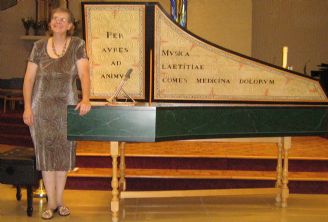|
Recital
ELEGANT VOCAL MASTERY AT ROSES SIGNATURE RECITAL
by Pamela Hicks Gailey
Sunday, February 25, 2024
Recital
DEMANDING SCHUMANN WORK IN MUSIC AT OAKMONT RECITAL
by Terry McNeill
Thursday, November 9, 2023
Recital
RARE RAVEL IN MENDO FESTIVAL'S PRESTON HALL
by Terry McNeill
Thursday, July 20, 2023
Recital
FRENCH FLAVOR IN RARE FOUR-HAND RECITAL
by Judy Walker
Sunday, January 15, 2023
Recital
ASSERTIVE PIANISM IN YAKUSHEV'S OCCIDENTAL RECITAL
by Terry McNeill
Sunday, November 13, 2022
Recital
HEROIC LIM PERFORMANCE AT STEINWAY SOCIETY RECITAL
by Abby Wasserman
Sunday, September 18, 2022
Recital
AGGRESSIVE PIANISM IN MYER'S MENDO FESTIVAL RECITAL
by Terry McNeill
Thursday, July 14, 2022
Recital
UNIQUE ELEGANCE IN GALBRAITH GUITAR RECITAL
by Gary Digman
Friday, April 29, 2022
Recital
ALLURING GLASS WORKS IN WEILL RECITAL
by Terry McNeill
Friday, March 25, 2022
Recital
FORGOTTEN BACH SHINES IN YARDEN'S OAKMONT RECITAL
by Terry McNeill
Thursday, March 10, 2022
|
 |
 Harpsichordist Janine Johnson at the Oct. 16 Santa Rosa Concert |
CREATIVE ARTS SERIES OPENS WITH STELLAR HARPSICHORD RECITAL
by Joanna Bramel Young
Sunday, October 16, 2011
Impresario Beth Zucchino’s Creative Arts Series presented a recital by harpsichordist Janine Johnson October 16 at the Resurrection Parish in Santa Rosa. A small but appreciative audience heard Ms. Johnson perform works from the Baroque and Classical periods. The artist is well known to East Bay audiences as a performer and a builder and decorator of the instruments, working for 25 years with the renowned Berkeley harpsichord builder and restorer John Phillips.
The program was ambitious, covering both German and French harpsichord and organ composers. Opening the concert was a Toccata in C minor by the youthful Bach that was probably inspired by the Buxtehude, a composer Bach admired. Bach once walked to North Germany to study with the great older master. On the Flemish style double keyboard instrument Ms. Johnson moved effortlessly between lower and upper keyboards, creating contrasting effects – always giving a clear and vivid rendering of the music. During one dramatic section in the Toccata one was reminded of an operatic recitative, with its declamatory phrases and rich ornamentation.
Buxtehude’s Suite in E minor, next on the program, was full of arpeggios (or open chords) which Ms. Johnson said derived from lute technique. A suite is a traditional Baroque form, a collection of dances, which were often meant to be danced to. Each dance has its correct tempo and style, which Ms. Johnson demonstrated with different finger articulations and ornaments, bringing out the characteristics of each dance. This reviewer especially enjoyed the Courante, where the hand lifted lightly off the keyboard, leaving little spaces between the notes that enhanced the lively rhythms. The harpsichord, while unable to play loud and soft – that is why the fortepiano was given its name – creates variety and drama by other means, including length of notes, spaces between notes, and chordal and contrapuntal textures.
Johann Christian Bach, a Mozart contemporary, wrote his Sonata in G major about 1671, and it sounded quite different from the Buxtehude and J.S. Bach works. Written in the Classical style, his work sparkled with tender melodies in the right hand and Alberti bass effects in the left. The work was very charming and full of fun. Ms. Johnson told us that Mozart took many of J.C. Bach’s harpsichord sonatas and made arrangements of them.
Jean-Henri d’Anglebert was harpsichordist for the court of Louis XIV, and is probably the greatest harpsichord composer before Louis Couperin (1668-1733). D’Anglebert’s Suite in G minor exploited the resonant bass strings of the harpsichord, bringing forth a mournful, heartfelt dignity to the work. The Allemande was stately and sweet, with many rolled chords and ornaments.
The recital ended with Bach’s familiar Fifth French Suite in G major, composed in 1722. This suite, unlike the d’Anglebert, was not meant to be danced to, and could be played more freely. Bach elevated the dance suite to its highest point, becoming a form, rather than just background for dancing. Bach’s turns and trills throughout the suite were played with great elegance by Ms. Johnson. The jubilant Gigue ending created a big, full-throated sound with the coupling of the two keyboards and the lilting 6/8 rhythm of the dance. It was full of joy, and very uplifting – a fitting conclusion to an exquisite concert.
|

